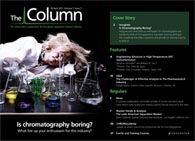Bloody good Mary
Flavour analysis of a Bloody Mary has provided some key insights into the best ways to mix the drink. The challenges and findings of cocktail?s analysis were presented at the 241st National Meeting & Exposition of the American Chemical Society.

Flavour analysis of a Bloody Mary has provided some key insights into the best ways to mix the drink. The challenges and findings of cocktail’s analysis were presented at the 241st National Meeting & Exposition of the American Chemical Society.
“It’s a very complicated drink,” said Neil C. Da Costa, an expert on the chemical analysis of flavours at International Flavors & Fragrances. “From the standpoint of flavour chemistry, you’ve got a blend of hundreds of flavour compounds that act on the taste senses. Most of the ingredients have been analysed for their key flavour volatiles, the chemicals that can evaporate from the glass and produce the aroma. Similarly for the non-volatiles, which are the chemicals that stay in the liquid and contribute toward the flavour there.”
These basic ingredients include tomato juice, Worcestershire and Tabasco sauce, fresh lemon or lime juice, horseradish, black pepper, and celery salt.Da Costa recommends high quality tomato juice to ensure a deep, rich flavour, but notes that the taste of vodka is masked by the other flavours and so cheaper vodka will suffice. He also advised that as the drink is highly unstable serving it on ice is a good way to slow the reactions that degrade the taste.
This story originally appeared in The Column. Click here to view that issue.
Analytical Challenges in Measuring Migration from Food Contact Materials
November 2nd 2015Food contact materials contain low molecular weight additives and processing aids which can migrate into foods leading to trace levels of contamination. Food safety is ensured through regulations, comprising compositional controls and migration limits, which present a significant analytical challenge to the food industry to ensure compliance and demonstrate due diligence. Of the various analytical approaches, LC-MS/MS has proved to be an essential tool in monitoring migration of target compounds into foods, and more sophisticated approaches such as LC-high resolution MS (Orbitrap) are being increasingly used for untargeted analysis to monitor non-intentionally added substances. This podcast will provide an overview to this area, illustrated with various applications showing current approaches being employed.

.png&w=3840&q=75)

.png&w=3840&q=75)



.png&w=3840&q=75)



.png&w=3840&q=75)








